A GLASS MENAGERIE - Anatomy of the Hemingray Factory Dumpsite
by Roger O. Lucas
Reprinted from "Crown Jewels of the Wire", August 2000, page 24
One of the most fascinating aspects of digging the Hemingray factory site in
Muncie that my "amateur industrial archaeologist" friends Darin
Cochran, Bob Stahr and I have experienced is of the layers of soil, sand, glass,
bricks and other objects. It's not only what is contained in each layer, but
also how they are laid out, thus giving us a history lesson on how Hemingray and
Owens-Illinois operated.
Our day usually begins by digging "test
holes" to see if an area has the potential for having glass shards from
production. Typically, a hole is made anywhere from one to two feet deep, and
around a foot across. If it looks promising, the hole is expanded and deepened.
If it seems nothing much is in it, then it's filled in and another test hole is
dug. There could be a succession of test holes dug all day, or perhaps we would
stick to one hole if shards are found, then creating a "crater" in the
ground. As a rule, the older Hemingray products and materials are deeper down
with the new Hemingray and Owens-Illinois items being closer to the surface. In
some cases though, Hemingray and Owens-Illinois stirred up older areas,
depositing their current items within them. Still, we can usually determine the
approximate age of the layers, even with the invasion of later dumpage. One
example of this is when I was digging through a late 1920's to early 1930's ice
blue bottle and insulator area, I found 1880's and 1890's oil lamp shards with a
peacock blue CD 151 shard in a thin vein running through a section of the ice
blue area. The ice blue area in question had shards of Blatz beer bottles among
others, some sodas, and several White House vinegar jug and bottle parts -- all
in ice blue, just as the insulators are.
Each individual layer seems to have its
own character about it, not only in how compact the glass-containing soil is
showing long-standing settlement, but the types and colors of soil from
different periods of time in Hemingray's long history. This soil is usually
consistent in its concentration of glass and other items from certain production
periods along with building materials coming from the same periods. The natural
soil in a layer might be of clay, hardpan, or even topsoil. Some layers may not
be soil-rich and is man-made, such as railroad ballast, a by-product resembling
black, burnt slag. Some layers are of pure glass like insulator parts, bottles, glass block and other pressed and
blownware, and/or crushed glass
with varying colors of glass cullet or "chunks." Other layers consist
of building materials such as bricks, furnace blocks and bricks and tile
roofing. Another layer may consist of metal such as bottle caps, nails, nuts and
bolts, tin, machine parts and even the occasional threading mandrel for
insulator pinholes.
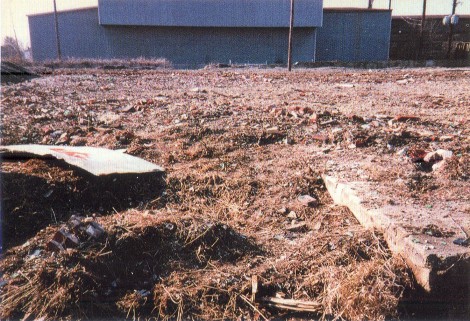
Two views of factory dump areas -- a "Field of Dreams".
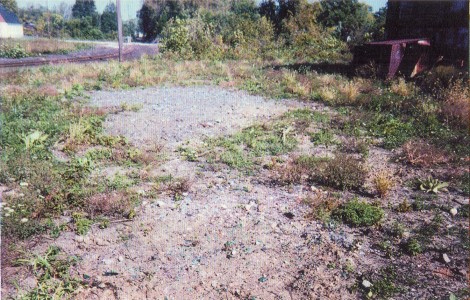
These layers can explain certain time lines in Hemingray's history as well.
First of all, the railroads came to Muncie, before the plant was built. This is
evidenced by the fact that there is railroad ballast in the next to lowest layer
in a test hole, above virgin soil like hardpan. The next layer up, which is
yellow clay, contains glass shards of early Hemingray production, such as Globe
fruit jars, tobacco jars, oil lamps and screw-capped flasks. (See top photo on
cover.)
|
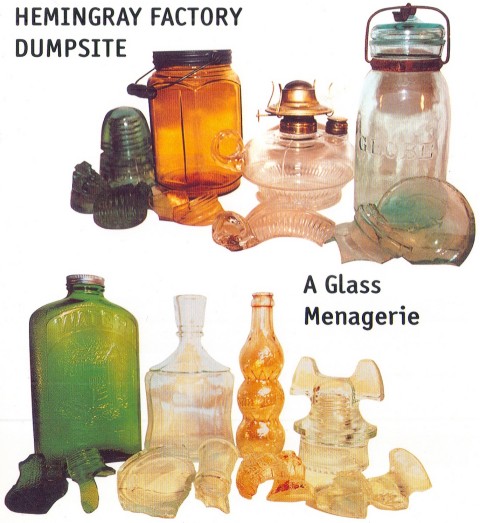
COVER: Two product groupings from different Hemingray
manufacturing eras grace the front cover this 'month.
Early Hemingray products and companion shards from the Muncie years
(1888-1905) include: CD 145 H.G.Co. Petticoat, amber Globe tobacco jar,
bracket lamp with applied handle to make a finger lamp, and an aqua Globe
fruit jar.
Late Hemingray era (1920's-1930's) include: A Wishing Well water bottle
in 7-up green, a clear White House vinegar decanter, a carnival glass Sun
Punch soda bottle, and a CD 257 Hemingray-60 with round drip points in
clear glass. |
A theory is, once the railroads were in, there was extra ballast that
was spread out on the ground level at the time. Next, the holes for the
foundations of the buildings were dug, which contained the yellow clay. The
topsoil and clay was then spread out around the new buildings. As expansion went
on, any soil removed had scrap glass from production mixed in then laid out towards the rear of the
property, where there was more room. Some dumping of soil with glass in it also
had been placed near the front and sides, but it's difficult to say exactly when this occurred -- perhaps earlier, perhaps later. The glass in clay soil at
the back of the property, that is laid out on top of the railroad ballast, is
very well mixed and is well bonded to the soil.
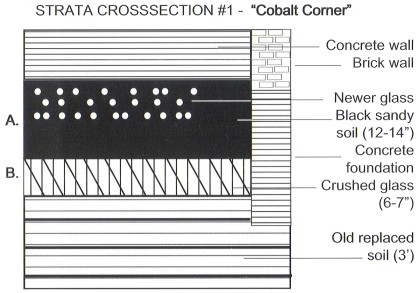
| Primary items in layers containing glass: |
| A. |
CD 162 Hemingray-19 rdp shards and whole in odd yellow/green
CD 162
Hemingray-19 shards and whole rdp and sdp in cobalt blue with various embossings
and CD 164 Hemingray-20 shards in rdp and sdp with various embossings.
Various
CD 162 shards in amber.
Various Hemingray blue cullet with amber streaks.
Various cobalt blue cullet.
Glass block shards.
Rubber bushings.
Brass bushings. |
| B. |
Crushed aqua insulators.
Crushed aqua cullet.
|
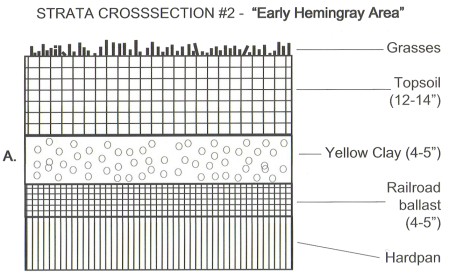
| Primary items in layers containing glass: |
| A. |
CD 104 New England Tel. & Tel. shards in aqua.
CD 134 Patent Dec. 19,1871 shards and whole in light aqua.
CD 145 H.G.Co. Petticoat shards in light aqua.
CD 164 H.G.Co. shards in light aqua.
CD 162 H.G. Co. sb shards in amber.
Various cullet in different colors.
2" layer of melted and burnt glass and insulator pieces with burnt
cedar wood. |
|
Various oil lamp shards including bases, stems, bowl parts, handles in clear,
peacock blue, amber and green. Globe fruit jar shards including lids, sides,
tops and bottoms in aqua, amber and clear, also blowovers. Globe tobacco jar
shards including tops, bottoms and sides in amber. Quilted flask shards
including screw threaded tops with blowovers. Various early bottle shards
including tops, bottoms and sides from d i fferent types and colors. Glass oil
can shards in light aqua including tops and bottoms. Milkglass bird feeder/bath
shards. Milkglass smoke bell shards including loops from tops. Various shapes of
glass knobs for jars, all handmade. Various inkwell shards including whole. |
In subsequent years, both
Hemingray and Owens-Illinois continued dumping layers of glass mixed with sands
of various types, soil, bricks, blocks, roofing and other items throughout the
property. Where gas, oil, water and drain lines were to go, additional soil was removed and placed
elsewhere, also mixed with dumpage. There were holes and ditches dug on
occasion, all across the property as well. Sometimes they seemed to pile up
glass and other things on the surface, letting vegetation grow over it or
perhaps the dumpage would sink into the ground. In one case, I think a pile of
CD 162 H.G.Co's were sitting around near a building that was subsequently torn
down, then the CD 162's were scooped into the foundation. We have dug up several
purple CD 162's from that foundation that range in shades from SCA/clear to
royal purple. The CD 162's were clear at first, turned purple in the pile over
time, with the outer ones getting darker and ones inside staying clear or light
purple, then all were placed into the foundation with soil, other insulators and
cullet.
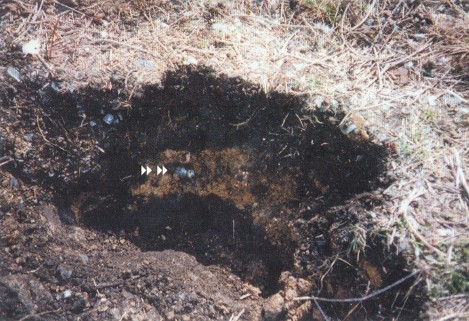
A well defined strata showing typical layer separation by color.
Note the oil
lamp stem "cylinders lamp" in the clay layer (arrows).
Through our use of test holes, we also have found small pockets of glass
that only go a few inches or so and stop. Other areas may have a lot of
undulation, with mixes of natural soils and man-made items, stretching several
yards. We don't know of course, when starting a hole, whether we are entering an
area in the middle or just skirting the rim. We have to be persistent and dig in
different directions to find out where the limits of a particular area are.
Over
the life of the plant, both Hemingray and Owens-Illinois built and tore down buildings, large and small, and rebuilt furnaces yearly.
Building bricks dot the ground in most layers along with furnace bricks and
blocks. It is interesting to note that most furnace bricks carry the names of the manufacturers on them and come in varying shapes and sizes. Some are even
coated with glass. A few building bricks have the name "M & S" on
them and appear to be vintage red bricks from the earliest post-wood plant
buildings.
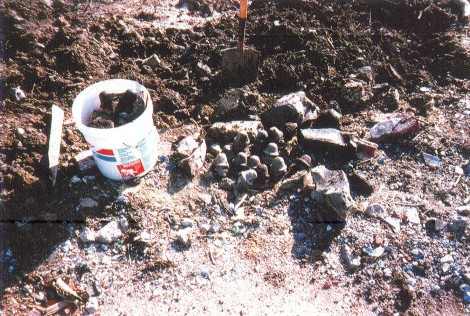
Red amber cullet chunks with CD 162 H. G. Co. purples.
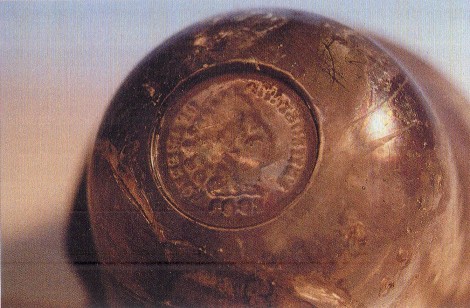
1901 penny imprint on a CD 162 purple H.G.Co.
Since our permission to dig might end at any time, we have tried to
concentrate on the areas that contain the earliest of Hemingray's production --
back to 1888 or so. Earlier in our digs, not realizing the extent of areas
having older items in them, we dug mostly in late Hemingray and Owens-Illinois
periods, such as ice blue, 7-up green and clear areas. (See bottom photo on
cover.) The earliest production is harder to identify for one thing, because
these items were made around a hundred years ago, and also most non-insulator items were known only to the wholesalers they sold to
and not after that. Our focusing on the early production is on bottles,
tableware, jars including battery jars, oil lamps and shades, various other
blown and pressed ware and previously unknown Hemingray marked and unmarked
insulators.
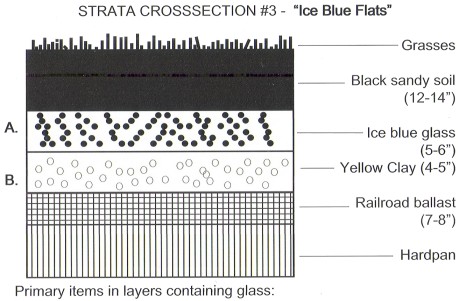
| A. |
CD 128 Hemingray E-1 ice blue shards and whole
Various ice blue
experimental insulators in shards and whole. |
|
Ice blue bottle shards and whole from various plain label types to many
different proprietary types including tops, bottoms and sides. Types including
beers, sodas, gins, whiskeys, horseradish, vinegar, sauces, wines and household.
Some names of embossed brands are: White House vinegar, Blatz beer, Cleveland
Metal Products (stove oil jar), Silver Seal Soda and we found solid pour ice
blue bottles.
7-up green bottle shards and whole from various plain label types
and a few proprietary types including tops, bottoms and sides. Types including
beers and sodas. One brand name is Queen City Soda.
|
| B. |
Oil lamp shards including stems and bases in clear
Globe fruit jar lids in
amber melted together in a stack.
CD 151 shards in peacock blue.
Split spool
insulator shards in milkglass and aqua. |
One piece of history we found while digging into the early period
was remnants of what I think may be items relating to the disastrous 1892 fire
in which Hemingray and their neighbor, C.H. Over Window Glass Company, burnt to
the ground. It is known that the first factory buildings were wood, then after
the fire, were brick. In one part of the rear property, in a hole containing
early period items, some two feet down, I found burnt cedar wood board pieces
with and in a two inch layer of burnt, melted glass containing old insulator
pieces and other ware. All this in the familiar yellow clay soil. Was this the
remains of the famous 1892 fire? To help support this theory is the fact there
were about twelve amber Globe fruit jar lids melted together in a stack, warped
milkglass smoke bell parts and slumped early insulators including light colored
CD 145 H.G.CO. petticoats and a couple different CD's with the Patent Dec. 19,
1871 embossing. Of course, there were other fires at Hemingray over the years,
but it had to be a great fire to create such a thick and long puddle of melted
glass that extends to the rear of the property. By the way, the cedar boards do
not smell burnt at all. They just smell like cedar.
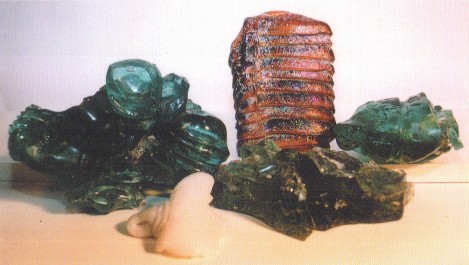
Suspect 1892 fire disaster results. Left to right: Combination of
various
aqua insulators, a dozen Globe fruit jar lids (rear), smoke bell
top (front),
2" thick aqua "puddle", CD 145 H.G.Co. Petticoat.
We may never know exactly if these items are specifically from the 1892 fire,
but what we do know is both Hemingray and Owens-Illinois buried things all over
the factory grounds. Perhaps for convenience, or maybe to level the ground in
places or use as cheap landfill to support buildings and drives. We don't know
if the dumping at the plant was done early on at just the plant, or
simultaneously at other sites like city dumps. Some of the same types of
production items from later years have been found by diggers at the "famous
dig" at a city dump some 25 years ago as we find now at the plant. An
exception is Lowex-named insulators. Virtually all Lowex must have gone to the
city dump because only a few minuscule pieces have been found by us. As far as I
know, the items in the earlier dig is of the 1920's era on up.
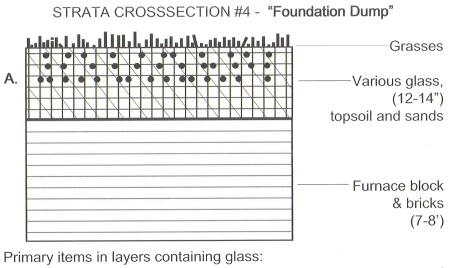
| A. |
CD 154 Hemingray-42, sb shards and whole Hemingray blue
CD 162 H.G.Co.
halves and 3/4 pieces in purple and clear
CD 137 Hemingray D-990's whole, over
poured aquas and experimental 7 -up green
CD 230.1 Hemingray D-512 shards and
whole carnival coated aqua
CD 232.1 Hemingray shards in aqua
CD 281 Hemingray-71
shards and whole aqua
CD 168 Hemingray D-510 shards and whole aqua
CD 1070
Hemingray 109 shards and whole aqua
CD 1105 Hemingray 103 shards and whole ice
blue |
|
Glass block shards, various other insulators shards in aqua, ice blue and
clear, various other newer pressed item shards in clear, red amber cullet, aqua
cullet. |
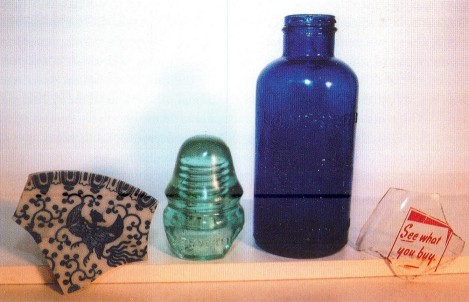
A grouping of seemingly out of place items from the factory dump.
Left to
right: Porcelain plate shard with a neat design--from the
commissary or ?, CD
133 W. Brookfield with absolutely no trace of
use--at plant for examination?,
Bromo Seltzer bottle in cobalt blue--
maybe used to make Hemingray blue or cobalt
insulators, and a shard
from a milk bottle--Hemingray didn't make these so it's
probably cullet.
The factory site
also contains things that seem somewhat out of place. One thing is window glass. There are shards of thick clear window glass as
well as stained glass, like church window glass in various colors and styles.
Since Hemingray didn't have the capacity to make large window glass, it probably
was made by Over Glass Company next door. After Over burnt to the ground with
Hemingray in 1892, it was rebuilt. Sanborn Fire Insurance maps show Over
operating in 1896, but between that time and 1902, it became American Window
Glass Company Plant #11 and was then torn down and the lot vacant according to a
1911 Sanborn map. At some point in that time, Hemingray purchased the land from
American Window Glass Company, and Owens-Illinois built the first glass block
warehouse bay by 1934. In the next couple years, two more warehouse bays were
added, which still stand today. The window glass we find now could be from Over
or American production or could be cullet altogether. Years later, during the
ice blue era, Owens-Illinois made window glass on a small scale we think, for
their own use or for a small contract. We have found ice blue shards of a couple
different patterns of window glass with a chicken wire-type mesh encased in the
glass along with ice blue bottles and insulators from that time period.
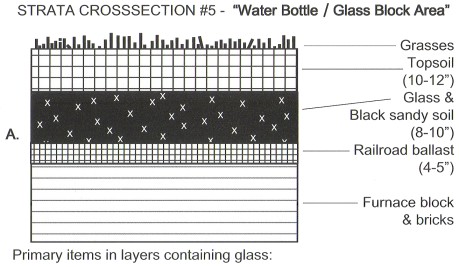
| A. |
Various glass block shards including solid pours. |
|
Water bottle shards
including tops, bottoms, sides in ice blue and 7-up green in various patterns,
and some solid pours. Beer bottle and soda bottle shards in ice blue. Ice blue
cullet. |
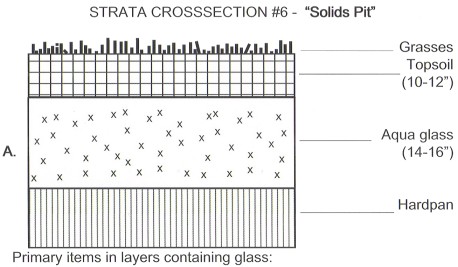
| A. |
Crushed aqua glass, including various insulators |
|
"Aqua cullet" -
including bubbly, jade milk, amber-streaked and two-tones, solid pour aqua CD
154 Hemingray-42's, solid pour aqua CD 106 Hemingray-9's, threading mandrels. |
Another group of seemingly out of place items we found are bottle shards and
whole ones along with various other glass objects made by manufacturers other
than Hemingray or Owens-Illinois. These were probably cullet that they bought
from scrap glass dealers, since we have found some bottle tops with caps still
on them. In some cases, bottles were used at the plant and thrown out along with
production scrap glass. I found a few shards and whole Coca-Cola 6 oz. bottles
with some having the Muncie, Indiana name on the bottom. Nehi soda and Barq's
root beer shards also were found. A number of cobalt blue Bromo Seltzer -
Emerson Drug Company whole bottles and shards have been found and have the '''M'
in a circle" embossing on the bottom, denoting they were made by Maryland
Glass Company. Bob Stahr's theory for these being present is they might have
been used to produce Hemingray blue, although I think they might have been used
in cobalt insulator production. Many Bromo Seltzers found had rusted caps still
on them. Perhaps the employees didn't bother de-capping these, so they were
tossed out along with other capped bottles, not of Hemingray origin. Many, many
bottoms also have been found belonging to the Bromo Seltzers. With such a number
of them, I can't believe they were at the plant to settle stomachs! Additional
non-Hemingray cullet shards include: milk bottles, Root Glass Company sodas and
various beer bottles.
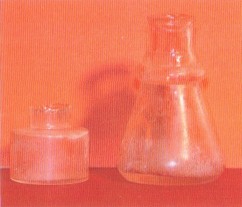
Two types of glass inkwells.
Small, very lightweight one and a
cone-shaped
heavier style.
It's now easy for us to distinguish between Hemingray made
and foreign made objects. We have gotten more familiar with molding techniques,
color differences and symbols used by glass manufacturers to separate out the
questionable glass. Other manufacturers have used the very same patterns that
Hemingray had on some of their products, so the finer points on how to tell has
become somewhat of an art.
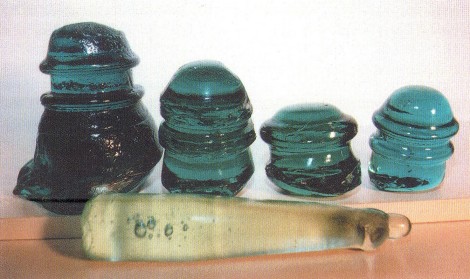
Some Hemingray "Solid Citizens".
Left to right: CD 154
Hemingray-42, CD 121 Hemingray-16,
CD 137 Hemingray D-990, CD 106 Hemingray-9,
and a solid bottle
in front resulting from the second step in an automatic press
not
happening before the glass hardened. The insulators were either
mold
warm-ups or molds coming apart.
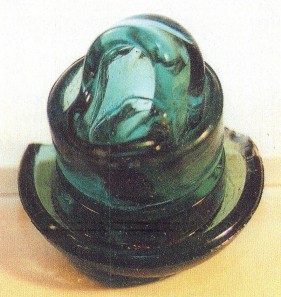
CD 1070 Hemingray-109 deadend style
that has a warped "big mouth"
opening.
Most of the time, we have located bottles and oil
lamps for example, after finding matching shards at the plant, in antique shops
and malls. In some cases, bottles and oil lamps have been found before the
shards. One example of this that still excites me, is a finger hold oil lamp my
sister has had for years, which has a hand applied handle that was suspicious to
me because very similar handles have been dug up by us at the plant. I borrowed
the lamp to show Darin and Bob, and since the pattern of the bowl is not known,
the technique of handle application made it possible. While I still had the lamp
at home, Bob dug up shards of that very pattern! One piece I got from Bob was
placed against the lamp and it fit like a glove. Needless to say, that lamp never
was returned to my sister. It became a birthday present to me, from her. I have
since located shards myself of the lamp, further proving its of Hemingray origin.
In locating these products of Hemingray, one has to be sure of its origin, so
money isn't wasted on look-alikes, when searching out Hemingray products in
antique malls, shops, flea markets auctions and wherever else. On a side note,
when one of us discovers an oil lamp, bottle or other Hemingray item, and the
others haven't seen the pattern yet, we bring it to the plant for "show and
tell", thus giving a homecoming to the item. It's an unusual feeling to
bring an item back to the place it was made a hundred years ago.
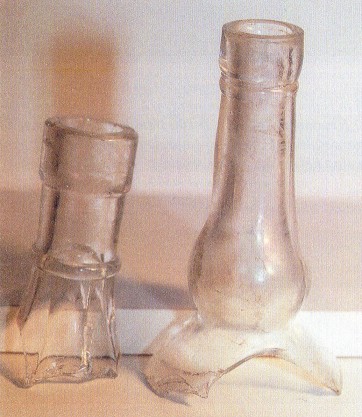
Two clear bottle tops dating to the late 1800's.
If it wasn't for the extended digging permission granted by the owner of the
plant site, the shards and items found to date might have been lost forever
making it truly impossible to learn all we can about Hemingray production. I can
certainly say that Hemingray was not just an insulator company, but a very
prolific Glass Company. They were larger than any of us thought, and they seemed to run the gamut in production from a simple
clear inkwell to a very ornate peacock blue table oil lamp. I hope to continue
to dig there in hopes of finding a shard from each category, if not each item
itself, therefore unlocking the mysteries of a long lost product line.
Thanks to
Bob Stahr and Darin Cochran, my digging compatriots, for assistance with the
details in this article and to Randy Kimery of Columbus, Indiana for
photographing the Hemingray products and companion shards.
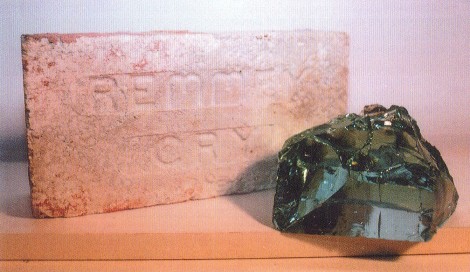
Furnace brick from the present "B" furnace which is being
demolished, and
a chunk of the last glass to flow from Hemingray-Muncie after
approximately
84 years there. The name of the manufacturer on the brick is
"REMMEY CRY",
which is certainly appropriate. Seeing the glass on the
floor of the furnace
chamber, a tear came to my eye realizing I was seeing the
very last glass
coming from Hemingray furnaces -- after a long 124 years of
glassmaking.
The following is a list of non-insulator glass shards and whole, non-pintype
insulator glass shards and whole and non-glass items of interest found in
various holes throughout the plant site. They come from both the Hemingray and
Owens-Illinois eras. Some newer items of glass were made under the
Owens-Illinois tradenames of Libbey, Kimble and American Structural Products. A
few items listed are items "presumed" to be certain types of products
and will be followed by a "?". More digging and research needs to be
done to confirm the unknowns we locate.
- Glass block shards in various patterns including factory-painted in several
colors and flashed amber. Blocks come in their own colors of ice blue, green
tint, smoke and clear.
- Picture tube faceplate and cone shards in clear and
smoke. Said to be for 1950's - 1960's television sets made by RCA and Zenith.
- Toothpick holders, tulip pattern, clear.
- Stoppers for 1950's Old Fitzgerald
whiskey bottles, called "Diamond Decanter", clear.
- Shot glass
shards, clear.
- Clothes washer door glass shards, clear.
- Glass land mine
shards, clear.
- Ice cream shop glassware shards from 1950's and 1960's, ribbed
pattern, clear, including sundaes, parfaits, sherbets and malts.
- Vase shards
in ribbed pattern, clear.
- Flower box shards in ribbed pattern, clear.
- Two
types of Globe tobacco jars shards including barrel shape in red amber and panel
pattern in yellow amber.
- Quilted and plain flask shards, clear, including
"coffin" shape and "pumpkin seed" shape.
- Various other
shards including tops, sides and bottoms of beers, ales, whiskeys and mineral
waters "?" in the colors of clear, olive green and ambers.
- Demijohn and carboy shards in clear and aqua. "?" (Large and thick
shards of big bottles were found.)
- Inkwells, including early small round plain
and early cone shape in clear.
- Wall tubes, ribbed, aqua and ice blue in
various sizes.
- Johnny balls, aqua, various sizes.
- Large jar lid shards,
clear, with brass or bakelite nuts.
- Various battery jar shards including tops,
bottoms and sides in clear and light aqua.
- Apothecary and laboratory item
shards in clear. "?"
- Ashtray shards, clear, in a couple of patterns.
- Syrup pitcher shards, clear, including tops, sides and applied handles.
- Miniature CD 154 Hemingray 42 in aqua.
- A couple of patterns of stove oil jars,
in ice blue and 7-up green.
- One gallon jug shards in ice blue.
- Mayonnaise-type
product jar shards dated 1958, clear.
- Various sizes and types of metal files.
- A few pliers.
- Various bottle caps including steel for beers and sodas,
aluminum for water bottles.
- Thread gage, no guts to it, but it's for a
standard pinhole.
- Gas valves including one named "Lynch".
- Brass
oil lamp collars and a couple of burners.
- Various metal and mechanical parts
such as pipe, gas line, valves, gauges, wire, blowpipes "?", angle
irons, nails, nuts, bolts, metal cutouts, tin and light sockets.
|
